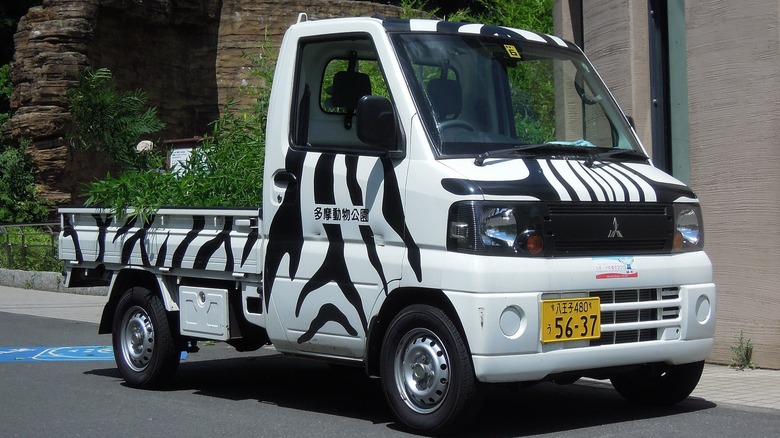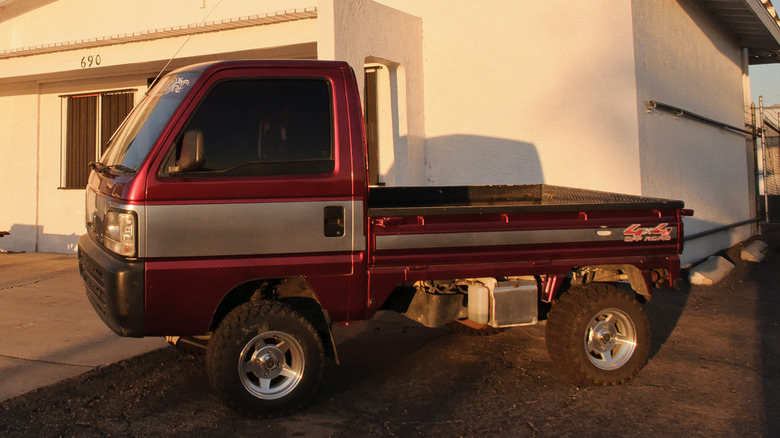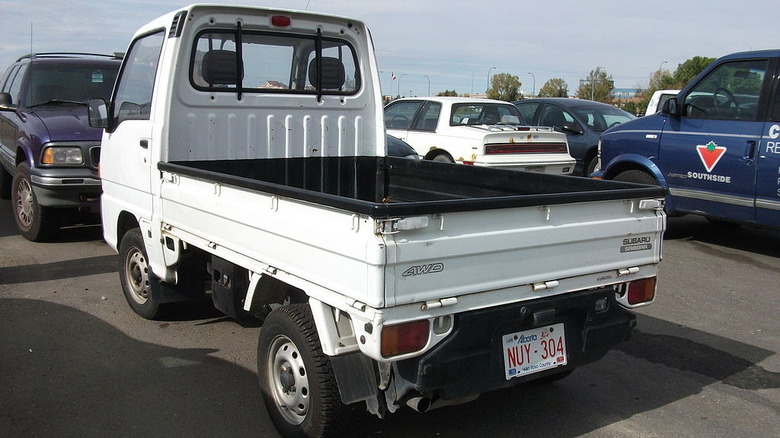What Is A Kei Truck, And Are They Legal In The US?
Collectible car insurer Hagerty defines Kei cars as "the smallest highway-legal passenger cars in Japan, a land of already small vehicles." Conceptualized by the Japanese government in 1949 as an ideal vehicle for densely populated cities, Kei cars have strict limits on external dimensions and engine size. The benefits of owning one are reduced taxes, insurance costs, and exemption from certain parking restrictions.
In 2014, Japan reduced the financial perks of Kei car ownership compared to their regular-sized counterparts, so the current popularity of the micro machines dipped somewhat from its peak. Nonetheless, they still represented approximately 34% of Japan's total automobile sales in 2022.
According to the latest restrictions from 1998, Kei cars are constrained to a length of 11.2 feet, a width of 4.9 feet, a height of 6.6 feet, and an engine sized 660 cubic centimeters or less with a maximum of 63 horsepower.
The name Kei car is a bit of a misnomer, however, because many Kei vehicles are vans and pickup trucks. Let's concentrate on the pickup trucks, which have a surprisingly large cargo bed because of their cab-forward design. As a bonus, many models also feature standard all-wheel or four-wheel drive. But can you drive one on U.S. soil?
[Featured image by Toshihiro Gamo via Wikimedia Commons | Cropped and scaled | CC BY 2.0]
Legality varies by state
In response to a flood of grey market imports in the 1980s (mostly Mercedes), the United States now forbids importing foreign cars that haven't been subject to federal pollution and safety standards. Until they hit the age of 25, which is considered classic status. Nearly all desirable, good-condition Kei trucks are considerably less than a quarter century old, but there may be a loophole depending on where you live.
Currently, approximately 20 states allow Kei trucks to be driven on the road — though not Kei cars — in the same vein that Utility Task Vehicles (a.k.a. side-by-sides) are street legal in certain areas. Typically, speed restrictions apply, as does a ban on highway use.
The same characteristics that make Kei trucks so well suited to crowded Japanese cities also apply to American cities. As such, they can sometimes be spotted as the vehicle of choice for construction and building repair trades, such as plumbers. Similarly, they make great vehicles for cleaning staff and maintenance crews at large resorts and campgrounds.
[Featured image by InSapphoWeTrust from Los Angeles, California, USA via Wikimedia Commons | Cropped and scaled | CC BY-SA 2.0]
An unlikely off-roader
Besides these functional roles that you might expect, off-roaders have also discovered the Kei truck. Often with a price of less than $10,000 and standard four-wheel drive, Kei trucks can be an affordable alternative to purpose-built vehicles like UHVs. While you're not going to find aftermarket support akin to a Jeep Wrangler, a cottage industry is emerging to supply suspension lift kits and beefier wheels to the Kei community.
So there you have it. Kei trucks are cheap, have traditional Japanese reliability, sip fuel, and might even be legal in your state. But before you grab a cold beverage and hop on eBay to find your next toy, there's one last thing to keep in mind. Like all Japanese Domestic Market (JDM) vehicles, Kei trucks are right-hand drive only.
[Featured image by dave_7 from Lethbridge, Canada via Wikimedia Commons | Cropped and scaled | CC BY 2.0]


